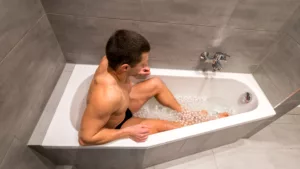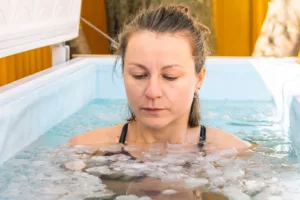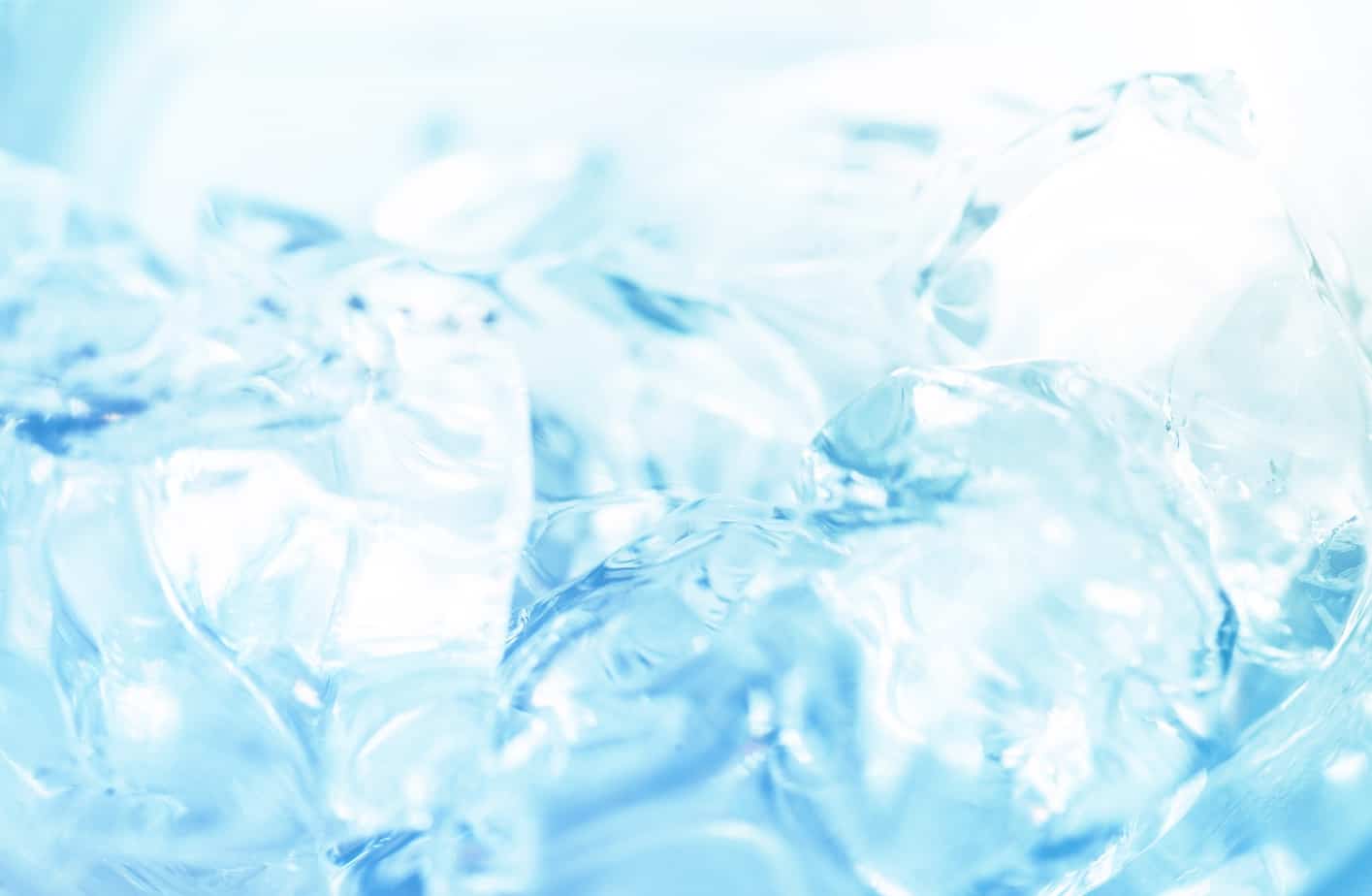Science Of Ice Bath Recovery For Fighters
In-Depth Guide
- Do Ice Baths Work? The Science Behind Ice Baths
- Factors To Consider When Using Ice Baths
- When Should You Ice Bath?
- How Many Times A Week Should You Ice Bath?
- Can Cold Showers Do The Same Thing?
- About the Author
- References
- Comments

Do Ice Baths Work? The Science Behind Ice Baths
Using ice baths for recovery does work. You may often hear that they aren’t as effective as people make them out to be. But that depends on many factors which I will cover below.
The science behind how ice baths work is by cooling the skin, muscle, and core temperature. This leads to constriction of the blood vessels slowing or blocking the flow of blood which may decrease swelling and acute inflammation muscle damage
Further, ice baths have been shown to acutely improve neuromuscular performance (jumps, sprints), enhance perceived recovery, decrease delayed onset muscle soreness (DOMS), and decrease creatine kinase (CK) levels (a stress marker that indicates muscle damage) (6, 7).
Decreasing CK levels may be one of the main benefits of ice baths for fighters. Fighters generally display high levels of CK after competitive fighting or even hard sparring so decreasing CK levels can help speed up recovery.
In fact, it has been shown that ice baths decreased perceived soreness, the stress hormone cortisol, and fatigue while maintaining jump performance in semi-professional MMA fighters after a simulated match (10).
So if ice baths work, can’t you just fill your big green rubbish bin with water and ice and go to town? Not so fast there Johnny boy! There are some factors you should consider before jumping into that bucket.
Factors to Consider When Using Ice Baths
The daily tasks for S&C coaches can vary greatly depending on whether you work in a team or individual sport, the level of the club or athlete, what resources and facilities are available, how much of your time has been contracted and perhaps most importantly the club or athlete culture.
Some clubs adopt the All Blacks type philosophy of ‘always sweep the sheds’ whereby an inclusive team approach towards menial non-performance tasks such as filling water bottles, carrying equipment and tidying the changing rooms after training and matches.
Whilst other clubs prefer for the staff to take care of all logistical tasks in order to remove all other non-performance-related considerations for the players. It really does relate heavily to the culture the leadership are nurturing and what their individual expectations are of you.

Body Mass & Body Fat
It is important to individualize your ice bath prescription based on your body mass and body fat percentage. Recent research has shown that core body temperature decreases at a faster rate in individuals that have less body mass and lower body fat percentages compared to individuals that have higher body mass and body fat percentages (1).
A second study reported similar findings when comparing larger football linemen to cross-country runners where smaller, leaner cross-country runners increased the rate of core temperature reduction greater than football linemen (2).
They found it’s not just how heavy or lean you are, but also how big you are. The greater surface area of the body also influences cooling rates when ice bathing.
So what is considered low and high body mass and fat with regards to core body temperature cooling rates?
Table 1. Male and female BMI results based on BM and BF.

Duration & Temperature
Now we know that body mass, size, and body fat percentage influence core temperature cooling rates, how can we use this information to prescribe ice baths
These guidelines are taken from Francisco Tavares, who has a PhD in recovery modalities. He likes to categorize ice baths by intensity through these 4 protocols:
Low: 8 minutes at 15ºC;
Moderate-Low: 10 minutes at 15ºC;
Moderate-High: 8 minutes at 10ºC
High: 10 minutes at 10ºC
Low body mass and body fat fighters are likely better to use ice baths in low and moderate-low intensities. While high body mass, low and high body fat fighters are likely better suited to moderate-high and high-intensity ice baths.
High body mass and high body fat fighters might benefit from greater exposure than the other two body compositions. Muscle temperature remained higher in this group compared to the lower body fat groups after the ice bath (1).
As skin and muscle reduce and re-warm faster than core temperature, greater exposure for high body mass and body fat fighters can benefit from performing two total sets instead of one. For example, 2 x 10 minutes at 10ºC with up to 10 minutes between.
In fact, performing the above-mentioned protocols in an intermittent fashion (i.e. 2 x 5 min at 15ºC) may be more effective than constant exposure for reducing muscle temperature (3).
You can measure the temperature of your ice bath easily with a simple floating pool thermometer.

Training Frequency
Many people intuitively look for external recovery means like ice baths when they are training more often due to increased soreness or tiredness. Research has shown that those who train only three times a week show no performance benefits when using an ice bath after each session compared to those who don’t (4).
This was likely because the 48 hours between sessions was enough time to recover between training sessions.
Fight Date
While many fighters probably won’t use an ice path 48 hours or closer to a fight due to weight cutting or other factors, it’s important to note that even if you were to do so, you may want to rethink the idea.
Ice baths have been shown to reduce ankle stiffness up to 48h after even though jump performance is improved (5). Why is this important? Because ankle or joint stiffness is what allows us to generate high velocities through elastic properties like a spring. Think about bouncing on your feet around the ring.
If your ankle is more pliable, you spend more time on the ground with each bounce and therefore, will be slower to move and react.
Having a joint that is too pliable may also increase the risk of injury due to increased joint stress. Stiffness is an important factor for striking especially when performing combinations such as switch kicking or double knees.
Training Phase
You may have heard recently that ice baths may blunt muscle growth adaptations from hypertrophy training.
Well, recent research in the Journal of Applied Physiology observed this when putting subjects through a three-day-a-week, seven-week weight training cycle (8). After each training session, subjects sat in a 10°C ice bath for 15 minutes.
They found that the ice bath decreased the muscle-building response post-exercise. A later study confirmed this response where ice bathing at 8°C for 20 minutes after weight training reduced the delivery and uptake of dietary protein (9). Which meant it severely blunts muscle protein synthesis (the ability to create new muscle).
This means that if you are in a training block where you are trying to add muscle mass or move up a weight class, then you should probably avoid using ice baths altogether as a recovery modality.
However, if your training isn’t focused on gaining mass, then ice baths can be a viable recovery strategy. During a fight camp would be a great time to use them as you need to be as fresh as possible leading into a fight and to have the highest quality training sessions.
It should be noted, these studies were performed on untrained individuals who only trained three times a week. A fighter’s training schedule may have three training sessions in a day! With hectic training schedules, a different story emerges when it comes to the use of the ice bath.
When Should You Ice Bath?
As you can see, there is a lot to consider when planning your ice bath recovery. But, we can take all of this information and piece it together to create a big picture regarding your ice bath recovery strategy.
To do this, we must consider the goal of your current training block. As we know, if your goal is to put on muscle mass, ice baths are not a good option. It could also be said that using ice baths during preparation training periods could also attenuate other physiological adaptations to training due to decreasing the inflammation response.
This is especially important when dealing with fighters that are relatively new to the sport or a certain training stimulus such as weight training. Since they have more room for improvement due to having a low training age, and the fact they often can’t express their maximum outputs, using ice baths may just slow down their progress.
Inflammation often gets a bad rap, especially in the media. According to the media, inflammation is the devil and we should be making sure we live in a zero-inflammation state 24/7.
However, inflammation is what signals our body to adapt. Without this stress, why would our bodies need to become stronger? Or develop the necessary traits to handle higher training loads?
In this case, perhaps using ice baths chronically may slow down the adaptation process when trying to acclimate to a training stimulus.

Conversely, what if ice baths could actually heighten our level of training within a dense training schedule? In fact, this is one of Dr Francisco Tavares’ main research points. Elite athletes in any sporting discipline train two or more times a day over consecutive days.
Just think about how much you need to get done as an MMA fighter. Stand-up, wrestling, grappling against the cage, ground game, strength training, conditioning training, and you only have so much time!
Even one discipline combat sports have a lot they need to get done from technical training, sparring, and strength and conditioning. So, can the use of ice baths help in a situation like this?
The only study to date on this topic is by Dr Francisco Tavares in elite rugby union (6). Rugby and combat sports have similarities in that both athletes receive high levels of muscle damage from contact, collisions, and weight training. Further, they both have jam-packed training schedules.
This particular study ran over three weeks during pre-season which consisted of four training days a week. Players had four weight training sessions, seven on-field rugby sessions, two-speed sessions, and three extra conditioning sessions per week. That’s a total of 16 training sessions in just four days! After the last training session on each training day, players sat in an ice bath for 10 minutes at 10°C while the control group did nothing.
The ice bath group reduced muscle soreness over the three weeks which lead to attenuating the decline in jump performance (-1.3 %) compared to the control group (-7 %). This suggests that athletes who used the ice bath were better recovered than those who didn’t.
Further, athletes in the control group saw a decrease in neuromuscular performance on day four of each training week. Meaning, due to increased fatigue throughout the week, athletes are likely to underperform by day four.
Similarly, chronic ice bath use attenuated the decrease in jump performance compared to the control group in volleyball athletes (11).
We can potentially conclude that using ice baths during periods of increased training volume may maintain high outputs of strength, speed, and power. This means, if you are not a beginner, and don’t have a goal of gaining muscle mass, frequent ice bath use during high training load periods may allow you to have better quality training sessions.
Better quality training sessions potentially means greater improvements in strength, speed, power, and technical ability.
How Many Times a Week Should You Ice Bath?
According to the above research, it can range from once a week to after every training day. It all depends on why you have decided to use the ice bath. One must remember that using external recovery means like the ice bath are the icing on the cake.
Everything else must be in order for you to reap the benefits. Things such as sleep, nutrition, and minimizing external stress should be addressed first before wondering how many ice baths you will take that week.
Secondly, just like with any stimulus, it should be periodized into your training year. Why? Because if you decided to ice bath five times a week for 52 weeks of the year, you start to adapt to the recovery stimulus.
As you adapt, the recovery response to the ice bath starts to diminish. How long does it take for this to happen? I’m not sure. I don’t think anyone has an exact number on this. However, it is a gradual process like anything is regarding physiological adaptation.
To mitigate this potentially happening to you, use the ice bath when you have high training load periods or you are leading into a competitive fight. Other than that, use other recovery modalities instead such as massage, contrast baths, foam rolling, or whatever else you have at your disposal.

Can Cold Showers Do The Same Thing?
Many of you may not have the equipment or space to set up your own ice bath. And when you get into a freezing cold shower, you may feel it’s doing the same thing anyway. But how true is this?
A recent study had subjects stand in a cold shower for 15 minutes at 15°C after exercising in the heat (12). They found that the cold shower did not decrease core body temperature, cortisol, or heart rate any more than the control group.
However, 30 minutes after, the cold shower group experienced lower heart rates than the control and also perceived themselves to feel better. These findings suggest that you won’t get the same physiological recovery stimulus as you would when ice bathing, but the strategy is so easy to implement that it is well worth it just for the potential decrease in cardiac stress and to feel refreshed.
References
2. Godek, S. F., Morrison, K. E., & Scullin, G. (2017). Cold-Water Immersion Cooling Rates in Football Linemen and Cross-Country Runners With Exercise-Induced Hyperthermia. Journal of athletic training, 52(10), 902-909.
3. Barber, S., John, P., Brown, F., & Hill, J. (2017). The Efficacy of Repeated Cold Water Immersion on Recovery Following a Simulated Rugby Union Protocol. Journal of strength and conditioning research.
4. Broatch, J. R., Petersen, A., & Bishop, D. J. (2017). Cold-water immersion following sprint interval training does not alter endurance signaling pathways or training adaptations in human skeletal muscle. American Journal of Physiology-Regulatory, Integrative and Comparative Physiology, 313(4), R372-R384.
5. Kositsky, A., & Avela, J. (2020). The effects of cold water immersion on the recovery of drop jump performance and mechanics: a pilot study in under-20 soccer players. Frontiers in Sports and Active Living, 2, 17.
6. Tavares, F., Beaven, M., Teles, J., Baker, D., Healey, P., Smith, T. B., & Driller, M. (2019). Effects of chronic cold-water immersion in elite rugby players. International journal of sports physiology and performance, 14(2), 156-162.
7. Tavares, F., Beaven, M., Silvestre, R., Teles, J., Baker, D., Healey, P., … & Driller, M. The effect of cold water immersion during a pre-season week in elite rugby athletes.
8. Fyfe, J. J., Broatch, J. R., Trewin, A. J., Hanson, E. D., Argus, C. K., Garnham, A. P., … & Petersen, A. C. (2019). Cold water immersion attenuates anabolic signaling and skeletal muscle fiber hypertrophy, but not strength gain, following whole-body resistance training. Journal of Applied Physiology, 127(5), 1403-1418.
9. Fuchs, C. J., Kouw, I. W., Churchward‐Venne, T. A., Smeets, J. S., Senden, J. M., van Marken Lichtenbelt, W. D., … & van Loon, L. J. (2020). Postexercise cooling impairs muscle protein synthesis rates in recreational athletes. The Journal of physiology, 598(4), 755-772.
10. Lindsay, A., Carr, S., Cross, S., Petersen, C., Lewis, J. G., & Gieseg, S. P. (2017). The physiological response to cold-water immersion following a mixed martial arts training session. Applied Physiology, Nutrition, and Metabolism, 42(5), 529-536.
11. Tavares, F., Simões, M., Matos, B., Smith, B. T., & Driller, M. (2020). The acute and longer-term effects of cold water immersion in highly-trained volleyball athletes during an intense training block. Frontiers in Sports and Active Living, 2, 143.
12. Ajjimaporn, A., Chaunchaiyakul, R., Pitsamai, S., & Widjaja, W. (2019). Effect of Cold Shower on Recovery From High-Intensity Cycling in the Heat. The Journal of Strength & Conditioning Research, 33(8), 2233-2240.



